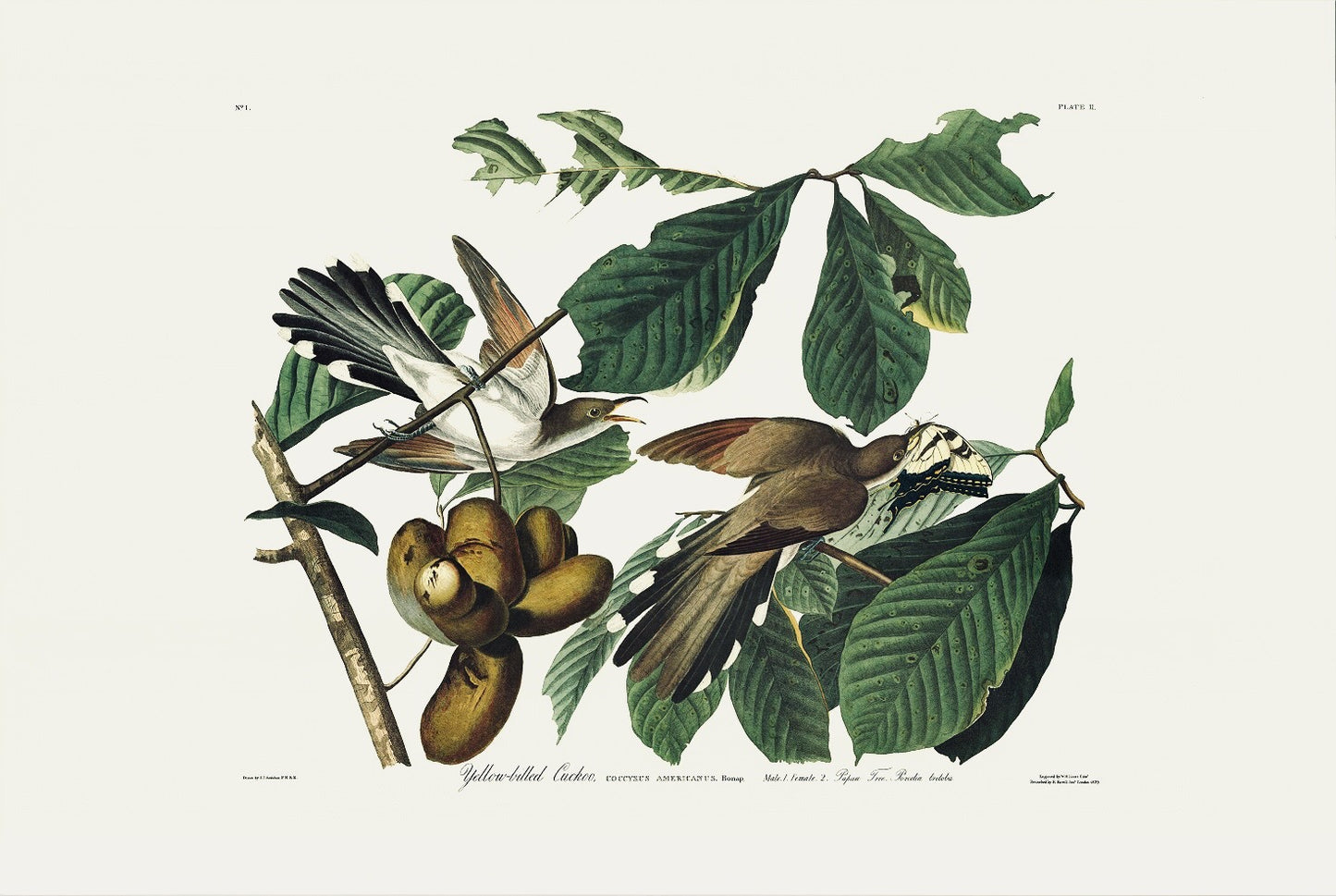Yellow-billed Cuckoo
The Yellow-billed Cuckoo
Princeton Audubon Double Elephant Edition •Double elephant (life size - 26 1/4 x 39 1/4) •Limited edition of 1500. •Pencil-numbered and embossed with the Princeton Audubon Limited seal. •Up to 11 color plates used. •Specially developed fade-proof inks. Absolute color fidelity to the actual original. •Printed on a 300 line. •Very heavy archival paper which is recommended by the Library of Congress for archives and is specially toned to match the actual color of the antique originals. •Registered to purchaser. •As permanently displayed at The Royal Society of London, to which Audubon belonged as a Fellow.
About the image itself ...
This print is based on a painting done in Louisiana in 1821 or 1822. Although cuckoos live almost entirely on caterpillars and seldom, if ever, eat butterflies, Audubon portrayed one of the birds seizing a tiger swallowtail. Joseph Mason probably painted the leaves and fruit of the pawpaw tree.
On December 10, 1826, Audubon wrote in his journal about the progress of the first proof impressions for Birds of America. "It is now a month since my work was begun...; the paper is of unusual size, called 'double elephant' and the plates are to be finished in such superb style as to eclipse all of the same kind in existence. The two plates now finished are truly beautiful. This number consists of the Turkey-cock [this painting has been chosen to prove the necessity of the size of the work], the Cuckoos on the pawpaws,..."
In seasons when caterpillars are abundant, cuckoos usually become common in the infested localities. They are especially fond of tent caterpillars and gypsy moth larvae, and with such plentiful food, the size of their broods seems to increase. Unlike the European cuckoo, American cuckoos only occasionally lay their eggs in the nests of other birds.
The Yellow-billed Cuckoo
Princeton Audubon Double Elephant Edition •Double elephant (life size - 26 1/4 x 39 1/4) •Limited edition of 1500. •Pencil-numbered and embossed with the Princeton Audubon Limited seal. •Up to 11 color plates used. •Specially developed fade-proof inks. Absolute color fidelity to the actual original. •Printed on a 300 line. •Very heavy archival paper which is recommended by the Library of Congress for archives and is specially toned to match the actual color of the antique originals. •Registered to purchaser. •As permanently displayed at The Royal Society of London, to which Audubon belonged as a Fellow.
About the image itself ...
This print is based on a painting done in Louisiana in 1821 or 1822. Although cuckoos live almost entirely on caterpillars and seldom, if ever, eat butterflies, Audubon portrayed one of the birds seizing a tiger swallowtail. Joseph Mason probably painted the leaves and fruit of the pawpaw tree.
On December 10, 1826, Audubon wrote in his journal about the progress of the first proof impressions for Birds of America. "It is now a month since my work was begun...; the paper is of unusual size, called 'double elephant' and the plates are to be finished in such superb style as to eclipse all of the same kind in existence. The two plates now finished are truly beautiful. This number consists of the Turkey-cock [this painting has been chosen to prove the necessity of the size of the work], the Cuckoos on the pawpaws,..."
In seasons when caterpillars are abundant, cuckoos usually become common in the infested localities. They are especially fond of tent caterpillars and gypsy moth larvae, and with such plentiful food, the size of their broods seems to increase. Unlike the European cuckoo, American cuckoos only occasionally lay their eggs in the nests of other birds.
